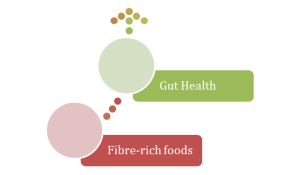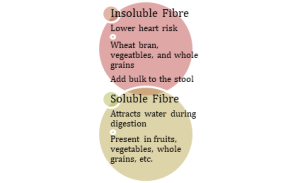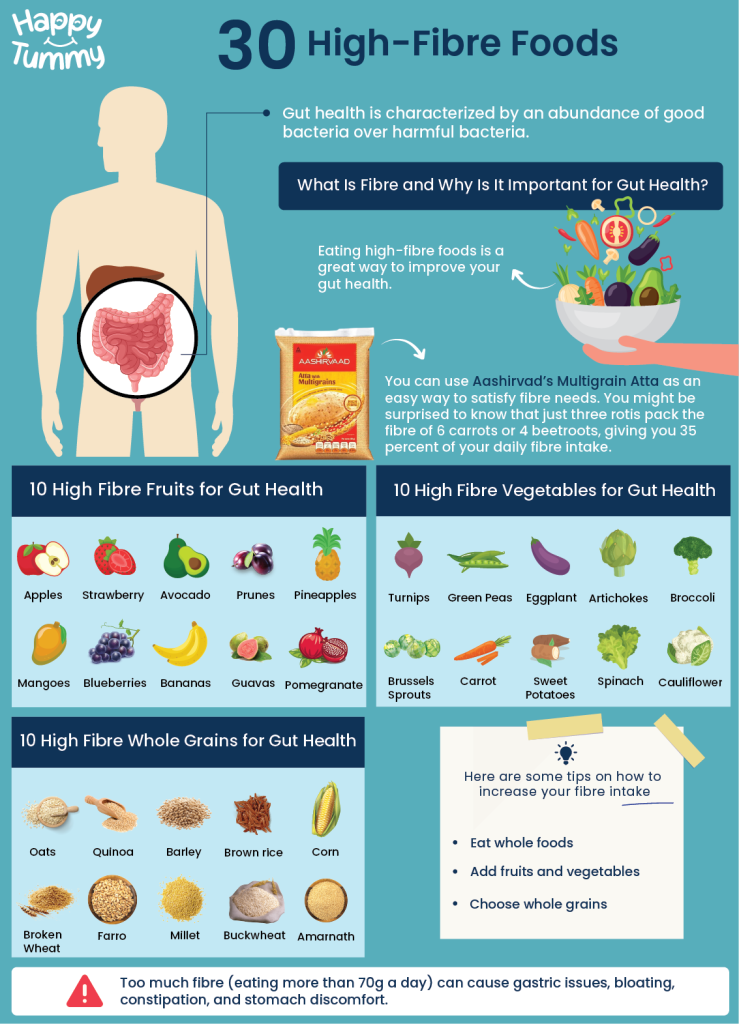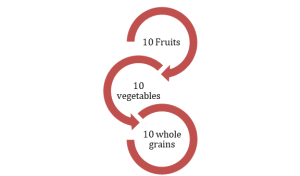Table of Contents
Hey, you! Want an easy way to level up your gut health? If yes, stay tuned until the end of the blog, as we’ve got just the thing: fibre-rich foods.
Food is not only eaten to gain energy but has a significant impact on our lives as food is associated with mood changes and health.
The belly rules the mind…
In short, good food lifts our mood and health. Regarding mood, we want delicious food that tastes yummy, simultaneously making us fit and healthy. We need food that supports our gut health because good gut health is the key to our holistic health and well-being.
Now, let me explain gut health.
What is Gut Health?
The gastrointestinal tract is primarily responsible for the digestion and absorption of nutrients and for eliminating waste products because our intestines cannot digest nutrients of this type.
The health of this part of our body is called intestinal health or gut health. Good Gut health is critical because it offers several health benefits.
Gut health is characterized by an abundance of good bacteria over harmful bacteria.
How is gut health determined?
Your gut health is determined by many factors, such as hereditary factors, the environment, and medications, but the primary factor is your diet. To maintain good intestinal health, you should choose fibre-rich foods in your daily diet. These high-fibre foods will help with digestion and give you a boost of energy throughout the day.
But which high-fibre foods should you add to your grocery list as per the nutrient value they offer to your health?
It’s a million-dollar question, so we’ve compiled a list of the top 30 nutritionally dense and fibre-rich foods to consider.

Each ingredient has its benefits but taken as a whole, this collection of potent items will help you begin your journey to a healthier and happier gut.
Read until the end to learn more about these delicious, gut-loving goodies!
What Is Fibre and Why Is It Important for Gut Health?
Gut health is vital for so many reasons. Eating high-fibre foods is a great way to improve your gut health.
So it’s no surprise that fibre has become one of the biggest buzzwords in nutrition science.
But what exactly is fibre?
Fibre is an essential part of a healthy diet. It aids digestion by ensuring food moves through the intestines more quickly and producing firmer stools.
Fibre also feeds beneficial bacteria in your gut, promoting a healthier microbiome. Even it keeps you full for longer, which can help with weight loss!
You can use Aashirvad’s Multigrain Atta as an easy way to satisfy fibre needs. You might be surprised to know that just 03 rotis pack the fibre of 6 carrots or 4 beetroots, giving you 35 percent of your daily fibre intake.

Do you Know? Fibres are of two types, i.e., soluble and insoluble fibres

Fibre Myth 1: Fibers are best found in beans and cereals
Fact: Best fibre foods include fruits, vegetables, and whole grains.
How Much Fibre Does the Body Need for Optimum Gut Health?
The Dietary Guidelines by WHO sources recommend that women get at least 25 grams of fibre daily, while men should aim for 38 grams.
An adequate fibre intake help keep your digestive system humming, reducing cholesterol levels and even protecting against certain chronic illnesses, such as type 2 diabetes.
So why not make it easy on yourself by adding some delicious high-fibre foods to your diet?
Thirty nutrient-packed foods can help you do that! Incorporating these fibre-rich foods into your diet can be a great way to make your tummy happy!
Fibre Myth 2: Fibre is only of one type
Fact: Fibres are of two types: soluble and insoluble. Soluble fibre reduces risk of heart diseases. Insoluble fibre helps food pass quickly through the intestines.
Read on for the list below:-
30 Nutrient-Packed Fibre-Rich Foods That Improve Gut Health

Adding fibre-rich foods to your diet is one of the best ways to ensure optimal gut health. They are super nutrient-packed and help keep you full and increase regularity, keep your weight in check, lower your blood sugar levels, and support heart health.

They can lower cholesterol levels and make you feel relaxed.
1. #10 High Fibre Fruits for Gut Health
Until now, you might be taking fruits because they are tasty and rich in vitamins and minerals. Additionally, fruits could be a great way to level up your gut health because they are a great source of dietary fibres.
1.1 BANANAS
One banana can give a dose of 3-gram fibre count from a medium-sized banana, and a bundle of nutrients like potassium, vitamin C, vitamin B6, and folate that keep your gut microbiome and other parts happy!
1.2 APPLES
Every child knows this phrase “an apple a day keeps the doctor away. But why does it? Yes, guys, you guessed it, it’s fibre! Apples are highly rich in both soluble and insoluble fibres.
They provide pectin, a type of soluble fibre that can help clear out the digestive system.
Additionally, they are high in essential nutrients like vitamin C, K, copper, potassium & antioxidants, which help protect against free radical damage.
Fibre Myth 3: All fruits and vegetables contain fibre
Fact: While it might be accurate, but only partially. Some fruits and vegetables are the best sources of fibers. Examples are broccoli, kiwi, and peas.
1.3 AVOCADO
Avocado is a superfood like no other because of its wealth and healthy fruits; yes, we agree that its price is a pain, but avocado is a gain of health as it provides a healthy source of fat, along with lots of fibre.
It is perfect for adding to smoothies or toast with some almond butter to increase fibre intake.
Only one avocado gives approximately 10 grams of fibre (primarily insoluble). That makes it a superstar fruit for dietary fibre intake!
They also give us vitamins & minerals such as vitamins K, C, potassium, and folate.
1.4 PRUNES
Like humans, stereotypes are associated with fruits, too; funny, right?
One such myth is here “Prunes are dried plums that are usually eaten with special yogurts to aid in digestion.”
Despite this stereotype, prunes do have the ability to keep your digestive tract moving.
A serving of five prunes can give you 3 g of fibre.
In contrast, prunes contain an ingredient called sorbitol that has been shown to have laxative properties.
Prunes are so effective at relieving your digestive system that they are more effective than other standard constipation treatment options, such as psyllium.
1.5 POMEGRANATE
Pomegranates are spheroidal, red fruit.
That is quite a very similar-looking fruit, just like the orange. In orange, we got those pieces, but in pomegranate, we got to eat crunchy, juicy edible seeds called arils.
These pomegranate seeds are tiny, but their impact on your gut health, blood circulation, and blood purification is tremendous.
It is the 5th fruit in the series of fibre-rich fruit; now it is undeniable that it gives you a proper amount of fibre to include in your diet. Along with fibre, it gives you particular nutrients that help your body increase the red blood cells and purify your blood. It is a detoxification fruit.
1.6 PINEAPPLES
Difficult to cut but tasty to eat, they have the name Apple in them, and just like apples, they are healthy for our gut health.
Yes, we are talking about pineapple, the yellow fruit that is quite acidic in taste, and hence it helps your stomach to balance the acid in it and offers you fibre. 100 g of pineapple will give you 1.4 g of dietary fibre.
Pineapples are a vibrant source of fibre that our body needs, and their natural sweet fruits also offer you the sweetness of taste diabetic patients can eat even this.
1.7 BLUEBERRIES
These jewel-colored berries are packed with antioxidant benefits and lots of dietary fibre.
Studies have linked blueberry consumption with improved digestive health due to its high levels of polyphenols.
Its high alkaloid content also helps support gut microbiome balance by promoting the good bacteria that benefit our digestive system.
1.8 MANGOES
We are talking about fruits, and not including the king in the list will be unjust.
Undoubtedly, mangoes are loved by everyone due to their taste, but we need to educate ourselves about their nutritional value.
It is stated that approximately one cup of peeled mangoes provides around 2.6 g of fibre, and it is the best fruit or summer to enhance your diet with fibre and taste.
1.9 STRAWBERRY
Considered sisters of blueberries, the red strawberries that look tempting and taste quite sour and sweet at the time are both excellent sources of fibre.
Per 100 grams of strawberry fruit, you can get 2.5 grams of fibre, but that’s not all. Strawberry offers numerous antioxidants and nutrients like prosperous magnesium and Vitamin C that care for your holistic health.
1.10 GUAVAS
Guava is a delicious fruit that offers fibre and helps maintain cholesterol levels.
The fibre in it helps us decrease the bad LDL cholesterol and simultaneously helps increase the level of HDL cholesterol which is proven to be good for our health.
So, eat guava with a happy heart and a smile.
2. #10 High Fibre Vegetables for Gut Health
Vegetables are your best bet when it comes to boosting your gut health. Not only do they contain essential vitamins and minerals, but they also provide plenty of dietary fibre.
If you’re looking for high-fibre vegetables that you can add to your diet, here are a few to get you started.

2.1 BROCCOLI
Broccoli is a powerhouse of nutrition known as the cross-breed vegetable because the crossing between cauliflower and cabbage resembles small cauliflower pieces.
It is a hybrid vegetable. It is very beneficial because it provides a blend of nutritious antioxidants and is packed with fibre. One cup of broccoli provides three grams of fibre. Plus, it’s low in calories and can easily be added to any meal!
2.2 BRUSSELS SPROUTS (Bandghobhi)
Another excellent veggie choice is brussels sprouts! Do you know every cup of cooked brussels sprouts provides four grams of fibre, vitamin C, folate, and vitamin B6?
They’re also high in antioxidants and can help lower cholesterol levels and reduce inflammation.
2.3 ARTICHOKES (Haathi Chaak)
Artichoke hearts are a great source of dietary fibre, too—one medium artichoke contains 10 grams of fibre! These delicious veggies are also high in antioxidants and can help lower harmful cholesterol levels in the body.
Plus, artichokes taste great when cooked or served raw with dip!
2.4 GREEN PEAS
Green peas are the most awaited winter vegetable. We even freeze them to taste all year round. It is the superstar vegetable of winter because it tastes so good. But it is also a superstar among vegetables for health because one cup of peas can give you 8 grams of fibre.
Moreover, this green vegetable is an excellent source of iron, vitamin C, and vitamin A, which care for your hair, eyes, and glowing skin.
Why not give it a chance to improve your diet and health?
2.5 CAULIFLOWER
Cauliflower is a widely used low-carb alternative to all starchy vegetables. You can reach 28 grams of the recommended daily fibre intake with half a cauliflower.
2.6 CARROT
We mostly take carrots in the form of salads or juice. Since childhood, we have associated carrots with good vision and eye health because of Vitamin A in them. That’s true. But they are also excellent for boosting your gut health.
The fibre in carrots ( approximately 4 g in 1 cup raw) relieves constipation, provides the necessary fibre, and helps you maintain blood sugar levels.
2.7 SPINACH (PALAK)
Spinach is another leafy green vegetable high in fibre, containing around 4 grams per cup. It is also an excellent source of iron, calcium, and other essential nutrients that can help maintain healthy bones and teeth.
To enhance its benefits, you can taste spinach with paneer in the most famous curry of India, palak panner.
2.8 SWEET POTATOES ( Shakarkandi)
Sweet potatoes are root vegetables just like simple potatoes, and just like potatoes, they are also high in fibre, containing around 4 grams per medium-sized sweet potato.
They are also rich in vitamins A and C and other essential nutrients that can help support overall health.
2.9 TURNIPS ( Shalgam)
Turnips, the root vegetables, are high in fibre, containing around 3 grams per cup.
They are also a good source of vitamins C and K and other essential nutrients that can help maintain healthy skin and bones.
2.10 EGGPLANT ( Baigan)
Even though the eggplant looks like a potato, it belongs to the nightshade family, as does the tomato. Eggplant contains both soluble and insoluble fibre, making it an all-rounder. One cup of eggplant provides us with 2.48 grams of dietary fibre. Insoluble fibre is found mainly in the skin, while soluble fibre is found mainly in the flesh.
Anthocyanins, another powerful antioxidant, are found mainly in eggplant peels, giving them their deep purple color. Free radicals that cause chronic disease can be inhibited by antioxidants that fight them.
These are just a few fibre-rich vegetables that can help improve your gut health. These vegetables offer plenty of fibre and other vital nutrients – so start incorporating them into your meals today to improve your gut health!
Fibre Myth 4. It is easy to reach the recommended 25 g of fibre a day!
Fact: No, it is not. It would be best to have a thoughtful diet plan and consciously add fruits, vegetables, and whole grains. Consulting with a dietician can be beneficial.
3. #10 High Fibre Whole Grains for Gut Health
Whole grains are a great source of fibre and a great way to keep your gut healthy. Plus, plenty of vitamins and minerals in whole grains will boost your overall health.
3.1 OATS
Oats are high in soluble fibre, perfect for gut health. You can eat them plain or add them to smoothies or pancakes.
3.2 QUINOA
Quinoa is a whole grain full of minerals like magnesium and has good protein.
3.3. BARLEY
Barley is an ancient grain that contains beta-glucan, which boosts immunity and aids digestion. One cup of cooked barley contains about 3.5 grams of fibre.
3.4 BROWN RICE
Brown rice is another whole grain with plenty of fibre and a great source of vitamins and minerals, including magnesium, selenium, and manganese. Brown rice is versatile in many dishes, from stir-fries to pilafs.
3.5 BROKEN WHEAT (Daliya)
Bulgur wheat is an excellent source of insoluble and soluble fibre, which helps keep the gut healthy.
3.6 CORN
You must be happy to hear that your popcorn is a whole-grain snack and a great source of antioxidants. So, now you must not feel guilty while chomping on to it during your favorite movie show!
3.7 FARRO
Farro is an ancient grain similar to wheat but has a nuttier flavor and chewy texture. It’s high in fibre, with around 3 grams per half-cup serving, and is also a good source of protein and iron. Farro is an excellent grain for soups, stews, and salads.
3.8 BUCKWHEAT (Kuttu)
A gluten-free grain high in fibre and protein can help lower blood pressure and improve heart health.
3.9 MILLET
Millet is a nutrient-dense grain high in fibre, antioxidants, and minerals and can help improve digestion and reduce the risk of heart disease. You can use Aashirvaad’s Multi Millet Mix as an easy-to-add millet to your diet. It is a rich source of dietary fibre, protein, and magnesium.
3.10 AMARNATH ( Rajgira)
An ancient gluten-free grain high in fibre, protein, and amino acids can help regulate blood sugar levels and reduce inflammation.
Adding these fibre-rich whole grains to your diet can improve your gut health by adding variety to your meals and providing essential nutrients. Whether you use them as a side dish or add them to your breakfast bowl or salad, they will provide the fibre you need to stay regular and healthy!
So, The Key Takeaway…
Eating fibre-rich foods is essential to living healthily.
They can help improve your gut health, reduce your disease risk, and keep you feeling full. The fibre in your diet can help you eat regularly and combat bloating and other digestive problems.
If you want to reap the benefits of fibre, try incorporating some of these fibre-rich foods into your diet. Salads and soups are some of the best ways to incorporate fruits and vegetables. Of course, eat raw fruits and vegetables as comfortably as you can!
Add healthy fats and proteins to help your body absorb the fruits, vegetables, and grains you eat. As always, paying attention to your body’s needs and reactions when introducing contemporary foods into your diet is essential.
Your gut health will improve with the right combination of fibre-rich foods and a balanced diet.
FAQs on High Fibre Foods and Gut Health
Answer:-
Incorporating more fibre-rich foods into your diet can have numerous health benefits, such as improved digestion, lower cholesterol levels, and a reduced risk of heart disease and certain cancers.
Here are some tips on how to increase your fibre intake:
Start slowly: Gradually increase your fibre intake over several weeks to avoid bloating or other gastrointestinal discomforts.
Eat whole foods: Favor whole foods over processed foods Whole grains, fruits, vegetables, legumes, nuts, and seeds are fiber-rich.
Add fruits and vegetables: incorporate more fruits and vegetables into your meals. Make sure you eat at least three servings a day.
Choose whole grains: Switch to whole-grain slices of bread, pasta, and cereals. Whole grains contain many other essential nutrients, such as B vitamins, iron, and magnesium.
Answer:-
The two gluten-free whole grains that you can take are as follow.
Amaranth: A gluten-free grain rich in fibre, protein, and antioxidants that may help reduce inflammation and improve heart health.
Teff: An ancient grain that is gluten-free and high in fibre, protein, and minerals. It can help regulate blood sugar levels and improve digestive health.
Answer:-
20-35 g fibre a day is the recommended amount. It should be from foods and not from supplements.
Too much fibre (eating more than 70g a day) can cause gastric issues, bloating, constipation, and stomach discomfort.















